Reading Groups Centers With Common Core Checklist
At that place are a LOT of different means to run literacy centers.
For example, you can have students piece of work in pairs. Or they can work in larger groups.
You might have students work with their guided reading groupmates. Or mix groups up so that students work with peers at different levels.
You can let students choose centers. You can give them partial choice. Or you can determine the centers that students visit.
The options are endless!
So is there one "right" style to implement literacy centers? I actually don't think so. Ultimately, you lot have to do what works best for you and your kids.
But in this post, I'll share the framework that makes the almost sense to me! I'll cover topics like group, differentiating, and holding students accountable. AND I have a gratuitous souvenir for you at the terminate of the post!! 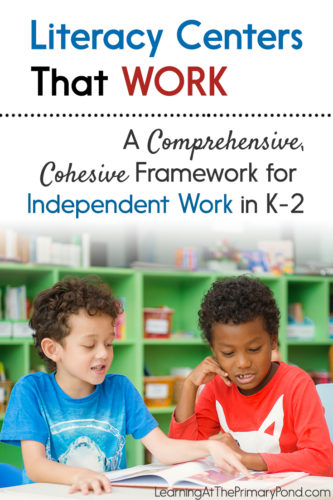
Photograph Credits: Tirachard Kumtanom, Shutterstock
What is the "Literacy Centers That Work" framework?
My "Literacy Centers That Work" model is structured effectually 6-7 work centers that students visit while the teacher meets with guided reading or other literacy small-scale groups.
Reading, writing, speaking, and listening are the foundations of the centers activities in this framework. Think of it as an ice cream sundae. Reading, writing, speaking, and listening are the ice cream (necessary for the sundae!). The unlike variations and activities are the toppings (fun and make the sundae taste even amend).
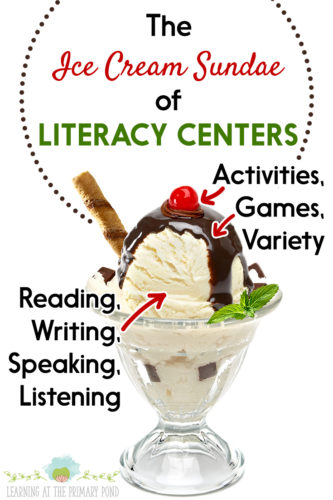
Photo Credits: Unal Ozmen
This framework likewise reflects the principle that students demand meaningful, authentic exercise to grow as readers and writers. Centers activities are derived from and tied closely to whole and small-scale group literacy teaching.
What are the different centers?
Nosotros need to select literacy centers that volition help students achieve the goals nosotros have for them. As readers and writers, we want our students to:
- Read with comprehension
- Decode new words successfully
- Read fluently
- Talk and write about what they read
- Aggrandize their vocabularies
- Share meaningful ideas through writing
- Write with correct spelling, grammer, and punctuation
With all that in mind, I chose the post-obit centers to incorporate different, meaningful ways that students can practise literacy skills:
- Independent Reading
- Reading Response
- Word Work
- Listening
- Writing
- Partner Reading
- Drama, Music, or Art Literacy Play (for kindergarten—optional, just recommended)
I suggest that y'all tell students which centers they will go to, and when. Students take pick inside each center—only more than about that after.
I also recommend that you use this same order of centers (1-vi, or 1-7) in the rotation. For example, Group A visits centers 1-3 on Monday and 4-six on Tuesday. The society of these centers was carefully selected so that students usually accept a balance of writing and reading activities each twenty-four hours.
Here are some in-depth descriptions of the different centers:
1. Independent Reading Center
This center is all virtually reading, manifestly and uncomplicated! It'south a serenity center—merely non necessarily silent, since many students in K-2 may be whisper reading.
In the independent reading centre, students may jot down thoughts, reactions, and questions on sticky notes, one-half-sheets, or on interactive bookmarks (pictured beneath). They write quick notes or ideas to share with their peers.
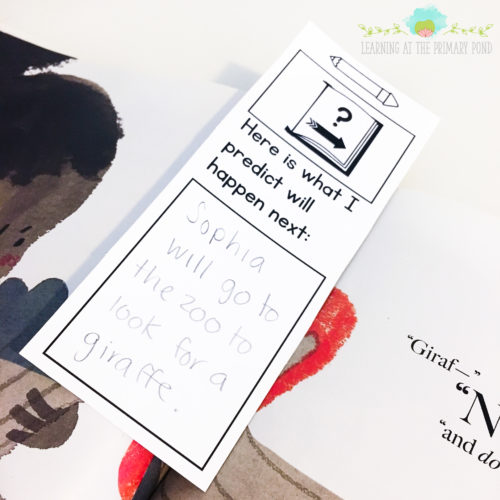
However, at this center, students don't spend time on lengthy written responses (or drawings). That takes place at the "Reading Response" eye.
Why? Because kids demand plenty of fourth dimension to just read. If we ask them to create lengthy responses during their reading time, it can a) reduce the amount of fourth dimension they have to do reading, and b) send confusing messages about whether they need to be reading or writing.
Likewise, students bring their own book bags or volume boxes to this center. They usually read only from their own book bags or boxes.
Kindergarten and early on get-go grade students should have x-12 books in their bags/boxes. Belatedly commencement form and second grade students might have betwixt half-dozen and 8 books, depending on the length of texts that they are reading.
I as well think it'southward important to ensure that students have at least some books in their bags that you know are at their independent level.
I typically create a volume shopping dominion like, "Select 5 books from anywhere in the classroom library, and 5 books from your grouping'southward bin." Inside the group bin, I tin can put a) books that students have already read during guided reading and b) other books that I know will exist at their independent level.
This combination strategy allows students selection. Simply it as well helps ensure that they're not always reading books that are way too difficult or way as well easy.
And speaking of volume shopping, the independent reading center is non an opportunity to shop for books. This fourth dimension is exclusively defended to reading. They can shop for books during other "downwardly times" in the day. I like to assign each guided reading group a book shopping day (or days), and students get new books as soon every bit they go far at school on that specified twenty-four hour period or days.
That said, kindergarten and early on start course students tend to go through books quickly—and if your centers concluding 15 minutes, that can be a long time for them to read independently! For these students, identify a five-minute sand timer in the center. When students get in, they turn the timer over and have 5 minutes to "shop" for new books in the classroom library. When the timer runs out, they must settle downward and begin reading immediately.
In addition to "regular" books, students can also read poetry, song lyrics, magazines, books written past other classmates, ebooks, etc.
One final note: In addition to the contained reading center, I also dedicate another time of the day for students to read independently (fifty-fifty if information technology's just an additional 5-10 minutes). Not all students will visit the independent reading center each day, but we want to ensure that all students accept an opportunity to read independently every solar day.
This separate independent reading time gives me a chance to meet with a few students for individual reading conferences and make sure that they are picking appropriate books for their bags.
Also, I've found that some students focus amend when everyone is reading at the same fourth dimension, and the form is quieter.
ii. Reading Response Center
This center provides opportunities for students to reply to what they read in Center #1 (independent reading).
Students bring their book bags or boxes to this center. They spend a few minutes:
- Selecting a volume or books to respond to
- Quickly reviewing parts of the volume and/or their sticky notes
- Choosing a method for responding to the book (more about that beneath)
- Chatting with their peers about the book they plan to respond to
A sand timer may exist helpful with instruction students to limit the amount of time they spend planning and talking.
A group leader might plough over a 3 or 5 minute sand timer as soon equally students enter the center. When the timer runs out, planning and talking stops and students begin working on their responses.
Typically, students will have 2-3 different options for how they respond to text. The options may vary, but can include: drawing or writing well-nigh a favorite office, cartoon or writing to show an interesting fact, designing a new comprehend for the volume, writing an culling catastrophe to the story, creating a new nonfiction book that combines information from several texts, answering a reader response question, writing a book recommendation for a friend, writing a letter to the writer, etc.
A response may not necessarily be finished in one twenty-four hours. Students may be finishing upwards a response from a previous solar day (I recommend that students spend no more than two days on any one response).
Students shop their unfinished or finished responses in their independent piece of work folders, which they bring with them to all centers.
3. Discussion Work Eye
In the word work center, students exercise reading, making, and writing words they are learning. These can include sight words, words with a particular pattern, and/or vocabulary words (depending upon students' levels).
At that place are many different ways that yous can organize this center. My personal preference is to take students work independently or in similar-ability partnerings. They practice their own words, which are kept on cards or in lists in their independent work folders. Words are selected for students based on their developmental needs, and they may exist function of a discussion study plan like Words Their Mode (my personal favorite).
In kindergarten (or even early first class), the word work eye tin outset out with proper noun piece of work, alphabet letter/sound work, and phonological sensation piece of work. You may also want to include 2 word study centers in your classroom at the beginning of the year and so that students accept many opportunities to practice these foundational skills.
In late first grade or second course, the word work center may include grammar and vocabulary work.
In that location are many, many possibilities for word work activities! Students can play games, stamp words, brand words out of Wikki Stix or playdough, use iPad apps, piece of work with magnetic letters, consummate discussion or flick sorts, and the list goes on.
I recommend limiting students to 2-3 choices at any given time. I also recommend didactics students a core grouping of games and having them play these games throughout the yr (using different words each calendar week or ii-week catamenia). This cuts downwards on the amount of time you have to spend preparing and teaching games.
four. Listening Center
In this center, students heed to pre-recorded stories or texts read aloud. They may also respond to the texts by writing, drawing, or talking to a partner.
When I first started teaching, I had cassette tapes for the listening heart. 🙂 But now there are and then many different options!
Y'all might apply a CD thespian (with a headphone splitter so multiple students can mind).
Yous could also utilise desktop computers, laptops, or tablets to have students listen to books online or in apps.
Students might also write a sentence or two about the text, like in this "passport" activity:
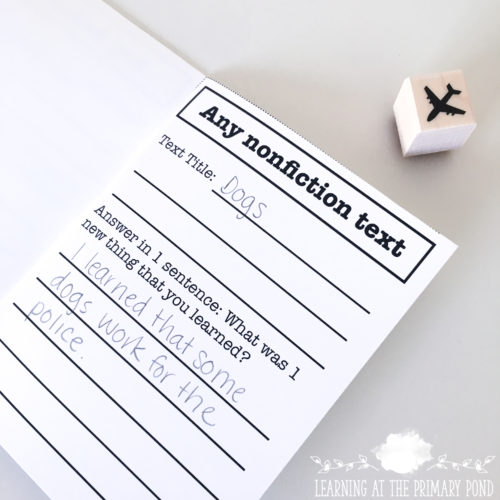
Students place finished work in their independent work folders, or get out it at the center if the audience of the work was their classmates.
v. Writing
In the writing center, students choose from a variety of writing tools and can work on dissimilar writing products.
There are many possibilities, merely here are just a few suggestions:
- Write an commodity for the course newsletter
- Write a letter to a friend or relative
- Create a how-to book to be placed in the classroom library
- Create a travel brochure almost their boondocks (or another place they have visited)
- Interview a friend and write a biography most them
- Work on a piece from writing workshop
Students shop their writing in their independent work folders so that they can hands return to it later. All the same, if they cull to piece of work on a piece from writing workshop, they put that piece dorsum in their separate folder for writing time.
6. Partner Reading Centre
In the partner reading centre, students work together to read and discuss texts in a diversity of means.
Again, in that location are tons of possibilities, but here are a few suggestions:
- Practice an repeat read (one partner reads one page and the other partner echoes it)
- Do a choral read (partners read the whole book at the same fourth dimension)
- Take turns reading pages of a volume
- One partner reads an unabridged book and the other partner then rereads it
- Reread a big book with a pointer (and search for certain words, punctuation marks, etc. subsequently finishing)
- Partners take turns video recording each other reading texts
- Act out a familiar story
Students frequently don't accept a tangible product after working in this center. But every bit I'll talk over subsequently, this is just fine. And y'all can pretty easily glance over and see if a pair of students is goofing off or actually reading. 🙂
7. Drama, Music, or Art Literacy Play (optional)
I know that non all of us piece of work in a school where the arts, drama, and play are prioritized. Just if yous are able to create a centre similar this, I retrieve information technology's a great idea to do then!
Depending upon how you structure the center, students might:
- Respond to texts through art (paint, markers, collage, etc.)
- Create something (i.e. a clay/playdough sculpture) and write near information technology
- Utilise puppets or props to act out a familiar story
- Engage in dramatic play (i.due east. a doc's part scenario, in which students read and write for diverse pretend purposes)
There are so many possibilities for this center! When I taught kindergarten, I always created a space for dramatic play in my classroom. If you're interested in resources to assistance you lot create a dramatic play eye based around literacy, look for my dramatic play resources (coming soon!).
Other Options for Centers:
I like using these half-dozen-7 essential centers for simplicity and ease of planning.
However, if you adopt to take a greater number of centers, y'all tin "break up" the different activities in these centers to make more centers.
For example, instead of having students read large books during partner reading, you lot tin have them read "regular books" during partner reading and plant a separate big volume station.
Or, instead of having students work with applied science in the discussion piece of work and writing centers, you might have a separate reckoner or iPad center.
You could also add together separate poetry centers, pocket chart centers, or fluency centers.
And you may need to intermission upward these centers if you have a large number of students—but more almost group sizes in a minute.
How long do centers last?
This depends upon a lot of things—where you lot are in your school year, what grade level you teach, how long your literacy block is, and how many pocket-sized groups or guided reading groups you desire to see.
Generally speaking, you probably desire to have students spend xxx-45 minutes TOTAL in centers each day. Each center can last nigh xv minutes for K-1. In 2nd form and upwardly, yous might use xv-20 minutes for each center.
How practice students rotate betwixt centers?
In my model, the teacher assigns students to centers. Each student visits 2-3 centers per day (fewer if he/she is seen past the teacher for guided reading).
Each center lasts equally long as one small group lesson, then all students rotate at the same time.
When it's fourth dimension to clean upwards, the teacher gives some kind of bespeak. When students are finished cleaning up, they sit down back downwardly and point to the center where they will go next. When everyone is ready, the teacher gives some other betoken, and students rotate.
Then that students are aware of how long they take to work in each heart, information technology'due south helpful to use some kind of visual timer (on the interactive white board, a sand timer, a timer with a big display, etc.).
As well, teachers need to create some kind of display and then that students know which centers they volition be visiting that day. The display can be created on a pocket nautical chart, bulletin board, or interactive white lath. The teacher (or a educatee helper) changes the parts of the display each day to reflect students' center assignments for that solar day.
How are students grouped?
Ideally, 4 students work in a center at one time. Even so, in many centers, students actually complete the activeness with 1 partner or independently. And then although 4 students may be in the center at the same time, all 4 children are not ordinarily working together (this helps reduce the noise level).
Each group of 4 students consists of 2 students from one guided reading group and ii students from a different guided reading group. This way, the instructor can specify that students piece of work with a aforementioned-ability partner OR a unlike-ability partner, depending upon the activity.
This gear up-up is also helpful because when a teacher meets with one guided reading group, there are nonetheless 2 children left in the center who can work together.
Of class, the math doesn't always piece of work out perfectly due to class size and absences. Hither are some tweaks you can make, if necessary:
- Have a grouping of 5 or a couple of groups of 5, with 2 kids from one guided reading group and 3 from another
- Teach students modifications for partner activities (and so they can complete them individually or in a group of 3)
- Temporarily rearrange groups if absences or other changes require it
- Break up one of the six-vii centers to create an additional middle
You can read more about this strategy (and see some videos) in this mail.
How are centers activities differentiated?
Many of the activities are accessible to all learners because students are reading and writing at their own levels.
However, here are some ways to ensure that students are working on advisable tasks:
- Require that half of the books in students' book bags come from a specific bin, with books at their independent level (read more virtually this under the contained reading center description)
- Give students differentiated word cards or lists that they go on in their folders (students then complete the give-and-take piece of work activities with their specific words)
- Use different colored folders in a center (each folder includes different activities, and students are assigned to work from a specific colored binder)
- Pair students up strategically (equally described in the section above, with same-ability and mixed-ability pairing options)
How are students held answerable for their piece of work?
Get-go, I want to say that although I retrieve it'due south very important that students are on-job and learning during centers, I am not a huge fan of assigning students tons of worksheets. I don't retrieve that kids have to produce something in every center that they visit.
That said, kids still need to know that they will be held accountable for their piece of work. We can do this past:
- Making eye goals very clear to students
- Checking students' independent work folders on a weekly basis (or a daily basis, if students are really struggling with staying on-task)
- Choosing 2-iii students to notice each day
- Making time for daily 1 minute bank check-ins (i.eastward. getting upwards from your small group to take a peek at what students are doing in centers)
- Keeping quick checklists available for those check-ins
- Having students take photos of non-written work for you lot to review (check out the awesome app Seesaw for this!!)
- Having a sharing time at the finish of centers where students can talk about their learning, share materials they created, and self-assess their productivity
How is choice incorporated into centers?
Choice is a powerful motivator! Although I assign groups and the centers where students work, I like to provide dissimilar options to students inside each center.
At whatever given center, there are e'er 2-3 different options for activities. These are represented on instructions cards: 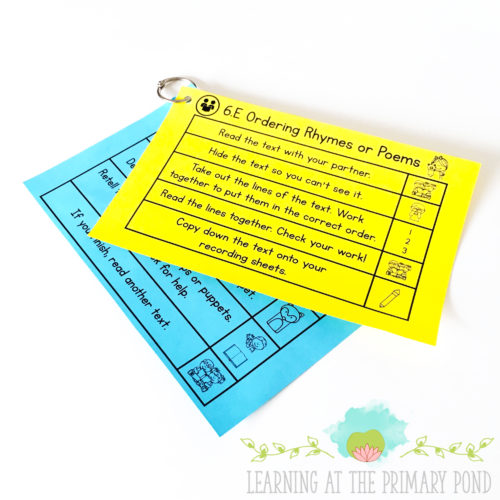
I only provide a few choices at a fourth dimension so that students don't get overwhelmed (and to make centers easier to make clean up!).
How are materials organized and rotated?
Each eye has a designated location in the classroom. You tin can store materials and take students work in that same space.
If you lot accept a pocket-size classroom or other space challenges, y'all may have to have students piece of work at desks or tables for some centers. You lot tin can still designate one location in the classroom where materials for that center will consistently exist stored.
In the past, I inverse out all of my centers on Mondays. Simply I found that this created "information overload" for my students when I had to teach them (or at least review) tons of new centers each calendar week.
Instead, I recommend changing out merely 1 activeness option for one-two centers per day.
So on Monday you might introduce a new activity for the listening heart (and the other ii options in that middle stay the same). And on Tuesday, you introduce a new activity for the partner reading centre (once more, the other 2 options in that eye stay the same). And on Midweek, you might introduce new activities for the independent reading and discussion piece of work centers. (And so on.) This mode, you lot're only spending a few minutes didactics i-two things before students start centers each day.
Also, before y'all ever introduce a center, you lot should model it repeatedly in whole group or pocket-sized group. For instance, have students play a word work game during guided reading before y'all identify information technology in the center.
Because your centers activities should be closely tied to your classroom didactics, model them during different times of the solar day. When information technology's time for centers, you lot might have to briefly review or explain a few things, but then it's simply a matter of placing the familiar materials in the eye for students to use.
In addition to the centers materials you lot set, students besides have their own independent work folders.
You can have students keep differentiated tasks, word lists, or word cards in their folders for apply during centers. Students also go along their writing, drawing, and other center-related tasks within the folders. If a production is "in progress," it goes in the pocket with the greenish sticker. If it is finished, it goes in the red pocket.
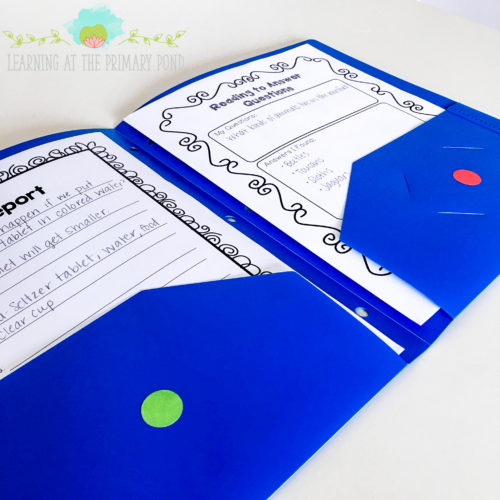
You tin review students' independent work folders on a weekly basis. Afterwards you've reviewed some of a child's finished work, you tin can a) paperclip finished work to signal that the child can take it home or b) place information technology in the kid's mailbox / other location for take-dwelling papers.
How practice centers fit into the literacy block or schoolhouse twenty-four hours as a whole?
That's a whole other brawl of wax 🙂 so I'm going to refer to yous to these other posts that I've written:
Fitting It All In: How to Schedule a Counterbalanced Literacy Block for Kindergarten
Fitting It All In: How to Schedule a Balanced Literacy Block for Commencement Grade
Fitting It All In: How to Schedule a Balanced Literacy Block for Second Grade
What To Practise When You Can't Fit All Of The Balanced Literacy Components Into Your Literacy Block
What if I need resources for my literacy centers?
I've got you covered! If creating engaging, meaningful centers for your 1000-two students is important to y'all – and you don't want to stay subsequently schoolhouse for hours and hours preparing materials, check out my Kindergarten, showtime grade, and 2d grade literacy center bundles.
You can also view the individual centers packs past scrolling downward to the bottom of each bundle clarification.
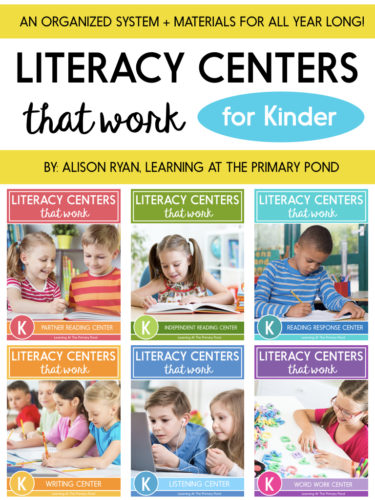
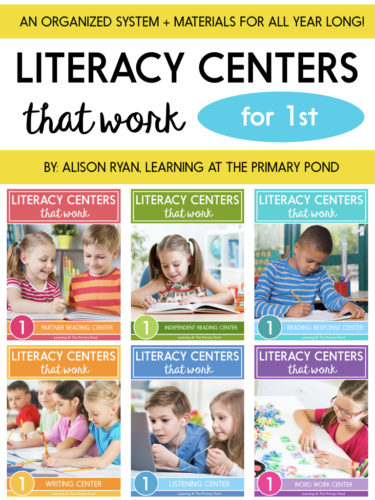
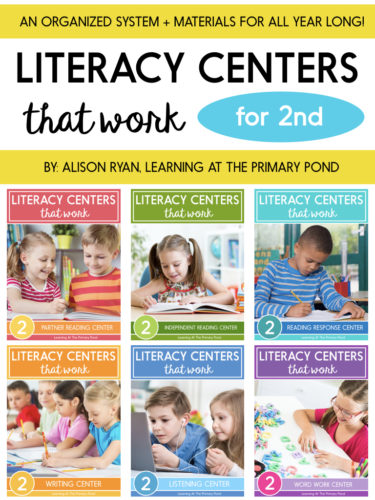
Let me know if you lot have any questions, and happy pedagogy!
Related Posts:
Source: https://learningattheprimarypond.com/centers/learning-at-the-primary-pond-literacy-centers-kindergarten-first-second-grade/
0 Response to "Reading Groups Centers With Common Core Checklist"
Post a Comment